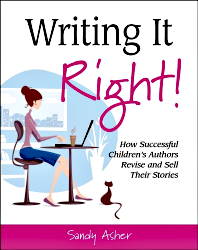Review of Writing It Right!
How Successful Children's Authors Revise and Sell Their Stories
by Sandy Asher
Contents
| Comments | To Buy
Purple
Crayon Bookstores
Book
Reviews Index Page

|
|
Revising a manuscript from rough draft to final, polished, publishable draft is an enormously important part of the writing process--few manuscripts spring fully formed from their author's imagination, after all. But how do experienced authors actually do it? Writing it Right! aims to show you, through a collection of case studies, based on actual manuscripts, tracing and discussing how they changed through one or more revisions, ending with the version that was actually published.
| Let people know: |
Contents of Writing It Right!: In 400 large-format pages, Sandy Asher follows 4 picture books, 7 magazine stories, 3 books for "younger readers" (easy readers, one nonfiction, and a chapter book), and 7 books for "older readers" (middle-grade and YA novels) from an early stage to their last, published form. Each is introduced with a brief description of the story, information about the author, and comments on the revisions. The stories follow, with notes in the margin, colored text to show what changed from one draft to the next, comments from the author about the change, and a closing conversation with the author. Authors range across a spectrum from well known to less so, and include Johanna Hurwitz, David Lubar, Judy Cox, Patricia Hermes, and Carolyn Reeder. Conversations with 4 editors and 1 agent about the revision process are also scattered through the book.
Asher shows how and why each manuscript was revised, framing the process with her "Nine Essential Questions," questions writers can use to help them work through the revision process, which begin with "Whose story is this?" and end with "Is this the best choice?" She shows different kinds of revision, ranging from major changes from one draft to the next, to line-edits, to careful tweaks to word choices. All of the case studies include at least two drafts, and sometimes three or four.
Some examples:
- Kate McMullan's I Stink is a dramatic first-person picture-book poem about a garbage truck. It went through many drafts; here we see the very first, two later drafts, and the published version, with comments on its evolution.
- Dinosaur Hunter by Elaine Mary Alphin is a nonfiction easy reader in HarperCollin's "I Can Read" program. The drafts included here show early work on it, and then the significant changes needed to make it comply with the requirement for a higher level in the program than the level for which it was originally intended.
- Vivian Vande Velde's User Unfriendly was written to be a companion piece to a middle-grade novel. We see 4 versions of the first page, and also sit in on a discussion of how the manuscript as a whole changed.
Comments As an editor, I love the process of revision, as I work with writers to help them make their manuscripts the best they can be. Every author and book goes through a different process, and Asher does a wonderful job of showing this across a wide variety of different kinds of manuscripts, which were revised in many different ways. Though other books about writing and revising give examples, I know of no other book that is built so entirely around the examples, and the approach illuminates the revision process. The subtitle, "How Successful Children's Authors Revise and Sell Their Stories," is quite accurate, though there is much more of an emphasis on the revising than there is on the selling--as there should be.
If anything is lacking in this, it's nonfiction, represented only by Dinosaur Hunter. I could also quibble about the organization: The "Books for Younger Readers" and "Books for Older Readers" categories are very broad, and Asher groups older middle-grade stories in with the YA in "Older Readers," though the YA category has always started at 12, not 10. However, if you are writing for a particular age group, and want to find those books, you need only check the "Target Audience," noted on the opening page of each case study.
Who Needs Writing It Right!: This is a great resource for writers who want to learn more about the revision process at first hand, rather than theoretically. If you've ever wondered how successful authors actually revised and polished a manuscript so that it could be published, this book will show you that, in considerable detail. I also recommend it for editors eager to broaden their knowledge of the editorial process, and for anyone curious about the process that takes a manuscript to a published book.
Where and How to Purchase Writing It Right!:
- Buy Writing It Right! at Amazon. It is out of print but you can find it used.
- Buy Writing It Right! at Amazon Canada, if you live in Canada.
- Buy Writing It Right! at Amazon UK, if you live in the UK: writing and revision are the same on both sides of the Atlantic.
You can, of course, also purchase this at any bookstore. If they don't have it in stock, they can order it for you.
Disclosure: I received a review copy of this book free of charge from the publisher, as do most reviewers. I also earn commissions on purchases of books via links on this site, as explained on my policy page.
This review is copyright © by Harold Underdown ( Google + Profile ). If you wish to reproduce it, please see the Terms of use. Last modified 3/23/2021.